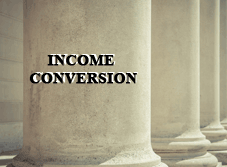Last updated: Mar. 4, 2013
 In the final article of our three-part series exploring the three pillars of tax-efficient investing, we look at income conversion.
In the final article of our three-part series exploring the three pillars of tax-efficient investing, we look at income conversion.
Please be sure to check out the first two articles – income deferral and income splitting.
Income Conversion
With income conversion you can receive tax-advantaged rates in your non-registered portfolio. Because different types of income are taxed at different rates you want to ensure that your investments are getting the best returns and cash flow on an after-tax basis.
It’s important to be aware of how the government treats the taxation of different investment vehicles. For example, preferential tax treatment is given to investment income in the form of eligible dividends and capital gains.
Interest income is fully taxable in your non-registered accounts, just like any salary, net business income and other regular income. However, Canadian dividends and capital gains receive preferential tax treatment.
Dividends from Canadian corporations are grossed up on your tax return and a special dividend tax credit applies. This generally means that dividends are effectively taxed at a much lower rate than regular income.
Capital gains are also effectively taxed at a lower rate – only 50% of net capital gains are included in your taxable income.
Since none of your investments are taxed as they grow within your registered accounts, the ideal scenario from a tax perspective would be to keep your fixed income investments in your RRSP to defer tax on the interest income and to hold your equity investments in your non-registered accounts to benefit from the preferred tax treatment of capital gains and dividends.
There are many other factors you need to consider in setting up your registered and non-registered portfolios, including diversification among asset classes and your degree of risk tolerance.
Keep in mind, too, that you must terminate your RRSP before December 31 of the year in which you turn 71. At that time you should convert the RRSP to either a registered retirement income fund (RRIF) or a life annuity in order to defer the income and tax payable over future years.
If you don’t convert your RRSP before the end of your 71st year, the full value of your funds will be taxable.
If you’re over the age of 65 and not part of a pension plan, you may be able to create income to qualify for the pension income credit and thereby save taxes. To do this, transfer your RRSP to a RRIF and then withdraw at least $2000 per year between 65 and 71 to maximize your pension income credit.
Minimizing the tax on your investments takes careful planning and can be quite complex. However, a tax advisor who is familiar with your personal, family and business situation will be able to offer guidance as to which tax plan strategies will be the most beneficial to you.
Learn About Advanced Tax Planning and How to Save More in Taxes
